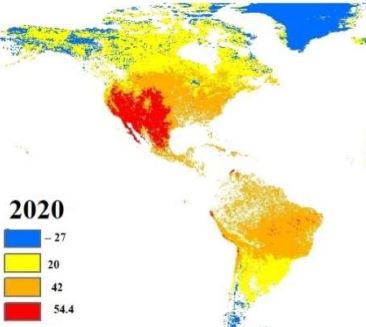Global Temperature Variations Since Pre Industrial Era
DOI:
https://doi.org/10.33411/ijist/2021030203Keywords:
Global temperature, Green house gases, pre industrial era, warming trends, carbon dioxideAbstract
The global temperature trends are being changed due to anthropogenic activities. The natural ecosystems and human societies are affected by this rapid climate change. These changes are caused by the increasing concentration of carbon dioxide and other green house gases including methane and oxides of nitrogen and sulphur. These changes can be identified using accurate data related to variations in temperature and precipitation. We used MODIS GLOVIS LST V6 global datasets to compute pixel-based temperature and mapped the trends. The considerable warming trends are exhibited by Arctic regions which are warming twice as compared to other parts of world. The largest increase in precipitation occurs in Northern Europe at the rate of 12.9mm per decade. The concentration of carbon dioxide has been raised up to 4.14 ppm in atmosphere by December 2020. This increased concentration has raised the global temperature up to 1.2°C since pre industrial era. Remotely sensed datasets provided promising results.
References
Abghari,H.,Tabari,H.,&Talaee, P.H.(2013).River flow trends in the west of Iran during the past 40 years: impact of precipitation variability. Global and Planetary Change, 101, 52–60.
Alexander,L.V.,Zhang,X.,Peterson,T.C.,Caesar,J.,Gleason,B.,Tank,A.M.G.K.,etal.(2006).Globalobservedchanges in daily climate extremes of temperature andprecipitation. JournalofGeophysicalResearch,111,D05109.
Ambenje,P.,etal.(2007).InS.Solomon,D.Qin,M.Manning,Z. Chen,M.Marquis,K.B.Averyt, M.Tignor,&H.L.Miller (Eds.), IPCC, 2007: climate change 2007: the scientific basis.ContributionofworkinggroupItothefourthassess- ment report of the inter-governmental panel on climate change(p.243).Cambridge:CambridgeUniversityPress.
T. Westerhold et. al., "An astronomically dated record of Earth’s climate and its predictability over the last 66 million years," Science vol. 369 (11 Sept. 2020), 1383-1387.
"Scientific Consensus: Earth's Climate is Warming". Climate Change: Vital Signs of the Planet. NASA JPL. Archived from the original on 28 March 2020. Retrieved 29 March 2020.; Gleick, 7 January 2017.
"The State of the Global Climate 2020". World Meteorological Organization. 14 January 2021. Retrieved 3 March 2021.
PCC, 2013b: Summary for Policymakers. In: Climate Change 2013: The Physical Science Basis. Contribution of Working Group I to the Fifth Assessment Report of the Intergovernmental Panel on Climate Change [Stocker, T.F., D. Qin, G.K. Plattner, M. Tignor, S.K. Allen, J. Boschung, A. Nauels, Y. Xia, V. Bex, and P.M. Midgley (eds.)]. Cambridge University Press, Cambridge, United Kingdom and New York, NY, USA, pp. 3–29.
IPCC, 2012a: Summary for Policymakers. In: Managing the Risks of Extreme Events and Disasters to Advance Climate Change Adaptation [Field, C.B., V.R. Barros, T.F. Stocker, D. Qin, D.J. Dokken, K.L. Ebi, M.D. Mastrandrea, K.J. Mach, G.-K. Plattner, S.K. Allen, M. Tignor, and P.M. Midgley (eds.)]. Cambridge University Press, Cambridge, United Kingdom and New York, NY, USA, pp. 3–21.
IPCC, 2014a: Summary for Policymakers. In: Climate Change 2014: Impacts, Adaptation, and Vulnerability. Part A: Global and Sectoral Aspects. Contribution of Working Group II to the Fifth Assessment Report of the Intergovernmental Panel on Climate Change [Field, C.B., V.R. Barros, D.J. Dokken, K.J. Mach, M.D. Mastrandrea, T.E. Bilir, M. Chatterjee, K.L. Ebi, Y.O. Estrada, R.C. Genova, B. Girma, E.S. Kissel, A.N. Levy, S. MacCracken, P.R. Mastrandrea, and L.L. White (eds.)]. Cambridge University Press, Cambridge, United Kingdom and New York, NY, USA, pp. 1–32.
Mysiak, J., S. Surminski, A. Thieken, R. Mechler, and J. Aerts, 2016: Brief communication: Sendai framework for disaster risk reduction – Success or warning sign for Paris? Natural Hazards and Earth System Sciences, 16(10), 2189–2193, doi:10.5194/nhess-16-2189-2016.
IPCC, 2012a: Summary for Policymakers. In: Managing the Risks of Extreme Events and Disasters to Advance Climate Change Adaptation [Field, C.B., V.R. Barros, T.F. Stocker, D. Qin, D.J. Dokken, K.L. Ebi, M.D. Mastrandrea, K.J. Mach, G.-K. Plattner, S.K. Allen, M. Tignor, and P.M. Midgley (eds.)]. Cambridge University Press, Cambridge, United Kingdom and New York, NY, USA, pp. 3–21.
Albert, S. et al., 2017: Heading for the hills: climate-driven community relocations in the Solomon Islands and Alaska provide insight for a 1.5°C future. Regional Environmental Change, 1–12,
IPCC, 2014a: Summary for Policymakers. In: Climate Change 2014: Impacts, Adaptation, and Vulnerability. Part A: Global and Sectoral Aspects. Contribution of Working Group II to the Fifth Assessment Report of the Intergovernmental Panel on Climate Change [Field, C.B., V.R. Barros, D.J. Dokken, K.J. Mach, M.D. Mastrandrea, T.E. Bilir, M. Chatterjee, K.L. Ebi, Y.O. Estrada, R.C. Genova, B. Girma, E.S. Kissel, A.N. Levy, S. MacCracken, P.R. Mastrandrea, and L.L. White (eds.)]. Cambridge University Press, Cambridge, United Kingdom and New York, NY, USA, pp. 1–32.
Dryzek, J.S., 2016: Institutions for the Anthropocene: Governance in a Changing Earth System. British Journal of Political Science, 46(04), 937–956.
Pattberg, P. and F. Zelli (eds.), 2016: Environmental politics and governance in the Anthropocene: Institutions andlegitimacy in a complex world. Routledge, London, UK, 268 pp

Published
How to Cite
Issue
Section
License
Copyright (c) 2021 50sea

This work is licensed under a Creative Commons Attribution 4.0 International License.




















